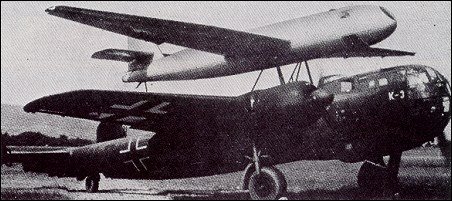| Andres Erdos, e-mail, 31.08.2012 04:36 The DFS 228 was a rocket-powered, high-altitude reconnaissance aircraft designed by the Deutsche Forschungsanstalt für Segelflug (DFS - "German Institute for Sailplane Flight") during World War II. By the end of the war, the aircraft had only flown in the form of two unpowered prototypes.
The initial design of the DFS 228 was undertaken before the outbreak of war as a research aircraft, the DFS 54, aimed at developing a high-altitude escape system for sailplanes. The project was suspended by the commencement of hostilities, but was revived in 1940 when the Reichsluftfahrtministerium (RLM - "Reich Aviation Ministry") delivered the DFS with a requirement for a rocket-powered reconnaissance aircraft.
The advantages of a sailplane for reconnaissance included its silence, its low speed relative to the ground (allowing for higher-quality photography), and its potential ability to loiter above an area of interest. The project gave the DFS the opportunity to investigate two additional areas that it was interested in - the effects of wing sweep on sailplane design, and supersonic flight.
The DFS 228 was designed by Felix Kracht and a first prototype was completed in March 1944 and was undergoing gliding tests by August, carried aloft piggyback on a Dornier Do 217. The aircraft was of conventional sailplane design, with long, slender wings, and intended to land on a skid mounted on its belly. The nose of the aircraft could be separated in an emergency, and formed a self-contained, pressurised escape capsule for the pilot. Because of problems with the cabin pressurisation system, the second prototype accommodated the pilot in a prone position.
Some forty flights were made with the prototypes, and installation of a Walter HWK 109-509 rocket was to have taken place in February 1945, but the project fell by the wayside as the war situation became more desperate. The second prototype was destroyed in an air raid in May 1945, and the first prototype was captured by US troops in June. In 1946, it was sent to the United Kingdom for study, where it was apparently scrapped in 1947, although its exact fate is unknown.
Variants:
DFS 54
Experimental glider with a pressure cabin, oxygen, cabin heating and insulation for high altitude flying.
DFS 228
Powered variant of the DFS 54 with a Walter HWK 109-509 rocket propulsion unit.
General characteristics
Crew: 1
Length: 10.58 m (34 ft 9 in)
Wingspan: 17.56 m (57 ft 7 in)
Wing area: 30 m2 (320 sq ft)
Empty weight: 1,650 kg (3,638 lb)
Gross weight: 4,200 kg (9,259 lb)
Powerplant: 1 × Walter HWK 109-509 liquid-fuelled rocket motor, 14.71 kN (3,310 lbf) thrust at sea level
16.18 kN (3,637 lbf) at operational altitude
Performance
Maximum speed: 900 km /h (559 mph; 486 kn) at sea level
Range: 1,050 km (652 mi; 567 nmi) maximum with intermittent powered flight
Launch altitude: 10,000 m (32,808 ft)
Glide descent altitude: 12,000 m (39,370 ft)
Service ceiling: 22,860 m (75,000 ft)
Absolute ceiling: 25,000 m (82,021 ft) reply |









